Content:
- How to choose a website feedback tool
- What to look for in a customer feedback tool
- The different types of website feedback tools
- Best Website Feedback Tools for 2025
- Conclusion
If you work on web development projects you'll know that clients often struggle to explain website issues clearly, using long email threads, screenshots, or spreadsheets, while web dev teams waste time trying to interpret vague comments, reproduce bugs without enough context, and manage scattered feedback across multiple channels.
There are many website feedback software platforms that will help streamline your user feedback process. These not only help gather feedback, they also track bugs, analyze feature requests, organize annotations, and capture the voice of the customer.
We have created this comparison to help you discover the perfect tool for analyzing different types of user feedback - so that your agency can spend more time on other priorities.
“Instead of sending feedback through scattered messages, teams can leave precise annotations directly on designs, documents, or live web pages… This eliminates guesswork, speeds up revisions, and helps projects move forward.” - DigiMagazine
How to choose a website feedback tool
Different agencies will have different needs when it comes to obtaining user feedback. The best website feedback tool for you really comes down to your goals and the type of input you want to collect.
- Reviewing websites – Obtain feedback from clients or your internal team during web development cycles.
- Bug reporting – Detect 'broken' buttons or functions.
- Usability testing – Understand how real users navigate your product.
- User acceptance testing (UAT) – Invite target users to test your app in a near-real environment to confirm it meets expectations.
- Gathering opinions – Want to know if your pricing feels right? Add a feedback form and capture hundreds of responses over time.
- Conversion optimization – Map the journey a visitor takes from landing on a page to signing up, and spot where they drop off.
- Reducing bounce rates – Investigate why so many people exit without clicking, scrolling, or exploring further.
No matter the scenario, there’s a feedback tool designed to fit the job - just choose the one that aligns best with your needs.
What to look for in a website feedback tool
There are generally five key features you should look for in your next website feedback tool to make sure that your process is streamlined and your customers have a great experience. Save time when comparison shopping by searching for these characteristics.
1. Simple, intuitive interface
All website feedback software comes with a learning curve. That doesn't change the fact that it should have a standard, familiar navigation interface and workflow, making it easy for you and your clients to use.
2. Easy installation
The best website feedback tools have a plug-and-play setup process. Install the extension on your browser or use the application platform—it's as simple as that. There's no need to interact with code.
3. Customizable workflows
Customizable feedback tools are a better alternative. However, most tools limit customization to their paid versions. You may need to sign up for a subscription if you plan to customize your data-collection tool.
4. Supports visual & video feedback during QA
Visual feedback (written, annotated, or captured via video) can provide profound insights during the QA process, especially when it comes accompanied with customer data.
Web designers and developers will know exactly what to do when they receive visual feedback and this makes your quality assurance or user testing process much more efficient.
5. Responsive customer support
Customer support is imperative and should be considered seriously before purchasing a user feedback product.
Check Out: Ways to Accelerate Review and Approval for Websites and Digital Assets

What are the different types of website feedback tools?
There are a number of user feedback tools on the market, each using different methods to collect feedback. In this blog we've categorized them based on their function. Consider your website's short-term and long-term goals to determine what type of feedback software yu need before committing to a product.
- Bug Tracking and Website Feedback Tools
- Online Survey Tools
- Usability and Behavioral Analysis Tools
- Voice of Customer Feedback Tools
- Community Feedback Tools
Here are the best website feedback tools for 2025
Bug Tracking and Website Feedback Tools
1. BugHerd
BugHerd is a visual website feedback tool that makes it super easy for clients to leave detailed feedback and bug reports, and is designed for users of all technical levels. Just send your customers a link and they're set to go - no account or login required.
Clients simply point, click and comment - BugHerd grabs a screenshot, saves technical details and creates a task for your team to track.
With its intuitive interface and ability to capture actionable feedback, BugHerd is the perfect tool for creative agencies and web development teams seeking to improve workflow efficiency, streamline project management, and enhance communication between web developers, designers, and clients.
With BugHerd, user feedback is quick, as is user feedback reconciliation. Teams are able to resolve issues fast, and dramatically speed up the website review and approval process.
With BugHerd feedback is effortless, clients are happier, and you'll build better websites.
"BugHerd makes it simple for clients to click on a live site, leave comments, and instantly turn them into clear, trackable tasks with screenshots, browser details, and device info." - George Vlasyev, BugHerd review
Key Features of BugHerd
- In-context visual feedback – Clients pin comments directly on a website via the feedback widget. They are able to leave a simple comment, annotate a screenshot, attach a file, and even leave feedback via video and audio recordings.
More on easy user feedback
- Automatic screenshot & technical info – With every piece of user feedback, BugHerd automatically captures more detailed feedback such as a screenshot, and user metadata (browser, exact URL, operating system, screen resolution, etc).
More on tech info collection
- Task management board – BugHerd comes with an in-built Kanban-style task board, enabling team members to manage feedback directly within the platform. This makes feedback management easy and ensures that everyone is on the same page. Remove duplicate tasks, assign them to your team for completion, and set severities.
More on BugHerd's task board
- Integrations & notifications – If you prefer to manage customer feedback using the tools you already have, BugHerd integrates with leading project management tools, customer service and CRM tools such as ClickUp, Asana, Trello, monday.com, Jira, Slack, MS Teams and many more.
See all BugHerd integrations
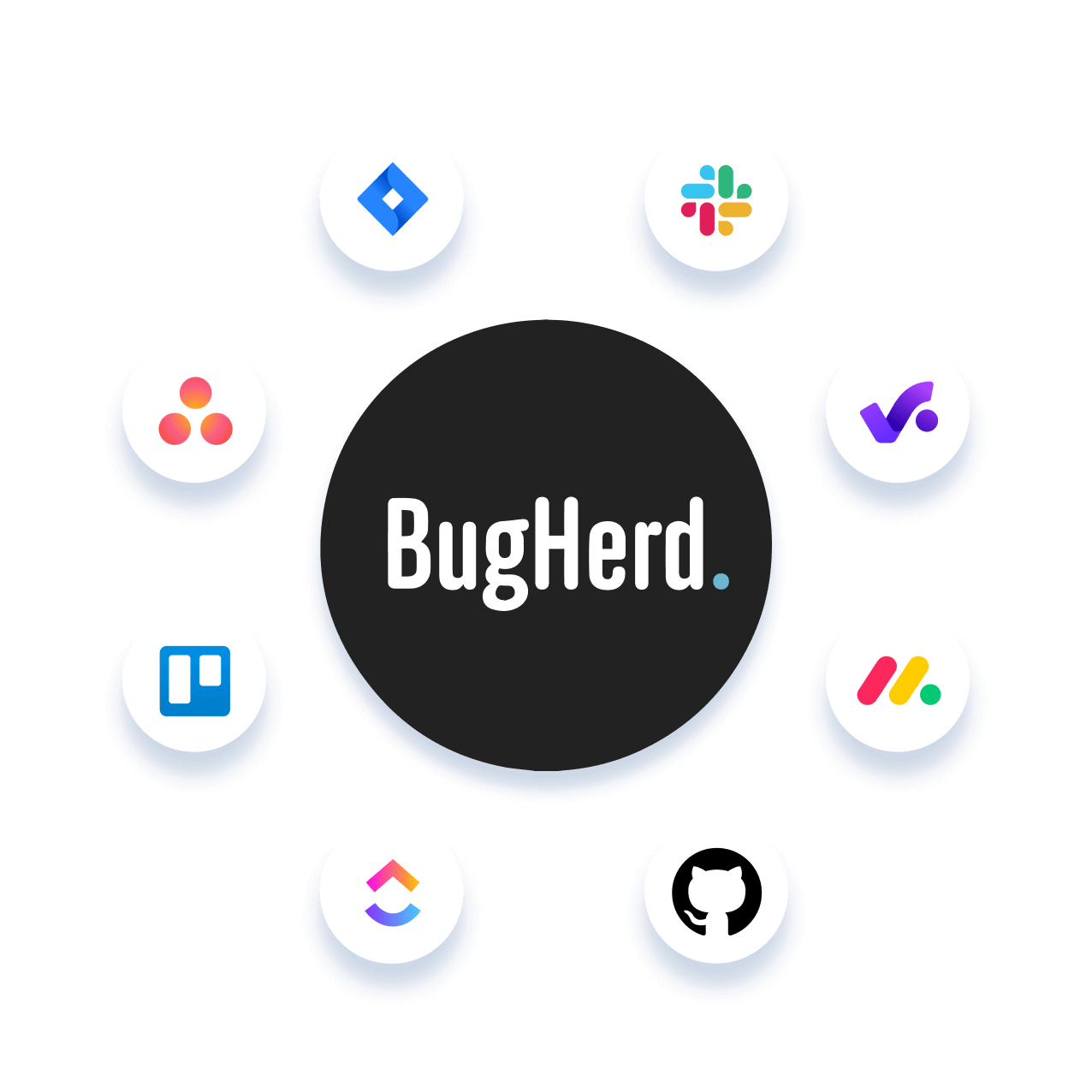
Benefits of BugHerd
1. Clients & teams find it easy to use: BugHerd has a simple interface and is known for its ease of use. Non-technical users can start leaving website feedback and bug reports immediately without having to learn a complicated system.
2. Improves customer satisfaction: BugHerd not only makes it easy for your clients to provide you with direct feedback, it helps keep them in the loop, and ensures that web development projects run on time and to budget. The end result: you will enhance customer satisfaction, increase repeat business, and be referred to other clients.
3. BugHerd is a cost-effective, all-in-one website feedback solution: BugHerd is an end-to-end user feedback solution which makes it easy for your clients to report bugs, and enables your team to collect feedback quickly and manage it efficiently.
"In a web development environment, efficient communication between developers, designers, and clients is crucial. BugHerd is a tool designed specifically to streamline this process by making bug tracking and client feedback simple and visual." - SmallbizCRM
Pricing
Starting at $42 per month for unlimited projects and unlimited guests, BugHerd offers great value for money.
Every plan comes with key features, essential integrations, and powerful tools, making BugHerd a budget-friendly choice for teams seeking a complete solution for their website feedback process. Whether you’re a small team or a larger organization managing complex web apps and live websites, BugHerd’s flexible pricing plans ensure you get the functionality you need without overpaying. View BugHerd pricing
BugHerd also offers a free 7-day trial so you can try before you buy (no credit card required).
2. Marker.io
Marker.io is a lightweight feedback tool that focuses mainly on bug reporting for developers. While it allows clients and team members to submit annotated screenshots through a browser widget, its feature set is narrower than many other platforms. The tool is geared towards technical teams who want browser logs and console data attached to reports, but it doesn’t provide the broader project management or collaboration depth that agencies often need. For non-technical stakeholders, the interface can also feel more like a bug tracker than a client-friendly feedback tool.
Key Features of Marker.io
- In-page annotation - Users click a widget to create a screenshot, annotate, and submit feedback.
- Automatic metadata capture - Every report includes browser info, OS, page URL, console logs, network requests, and other context.
- Session replay - See what the reporter did before submitting feedback.
- Integration with issue trackers / PM tools - Syncs with Jira, GitHub, Trello, ClickUp, Asana, Azure DevOps, and more.
- Customizable forms & workflows - Tailor what fields reporters see, map fields to your issue tracker, and control widget behavior.
Pricing
Marker.io's paid plans start at around $39/month for the Starter tier, which includes core features, but only 3 seats/members and 5 active projects. The Team plan (about $149/month) increases the number of seats and projects to 15, and includes advanced options like custom branding and integrations. Larger agencies can access Business and Enterprise tiers with extras such as SSO, audit logs, and priority support. All plans include unlimited feedback items and a 15-day free trial.
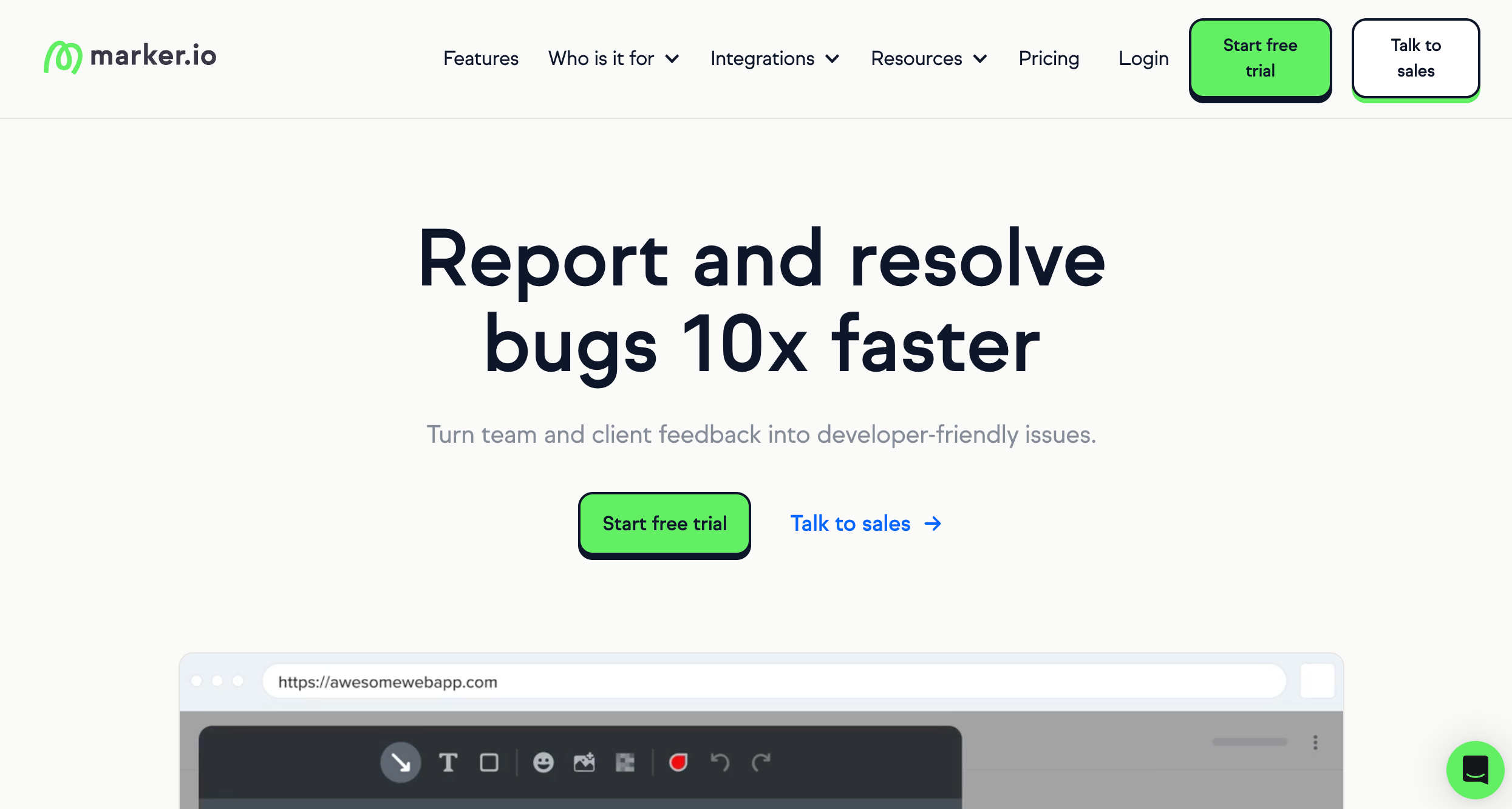
3. Userback
Userback is a visual feedback and user insights tool aimed at product teams, SaaS companies, and agencies. It lets users capture annotated screenshots, screen recordings, and in-app surveys, then centralizes that feedback with technical context and workflow tools. Positioned as more advanced than simple annotation tools, Userback also integrates directly into dev/project workflows.
Key Features of Userback
- Visual annotations on websites, apps, and designs
- Session replays and screen recordings for context
- In-app surveys (NPS, CSAT, CES)
- Automatic technical metadata capture (browser, OS, logs)
- Centralized feedback inbox with tags, priorities, and Kanban views
- Integrations with Jira, GitHub, ClickUp, Slack, Teams, Zapier & more
pricing
Userback offers a Free plan with limited feedback visibility (7 days) for up to 2 users and 2 projects, while paid plans start at $19 per user/month with the Business plan, which includes session replays, surveys, integrations, and up to 25 projects. The Business Plus plan (~$29 per user/month) adds unlimited projects, API/webhooks, SSO, and advanced privacy controls.
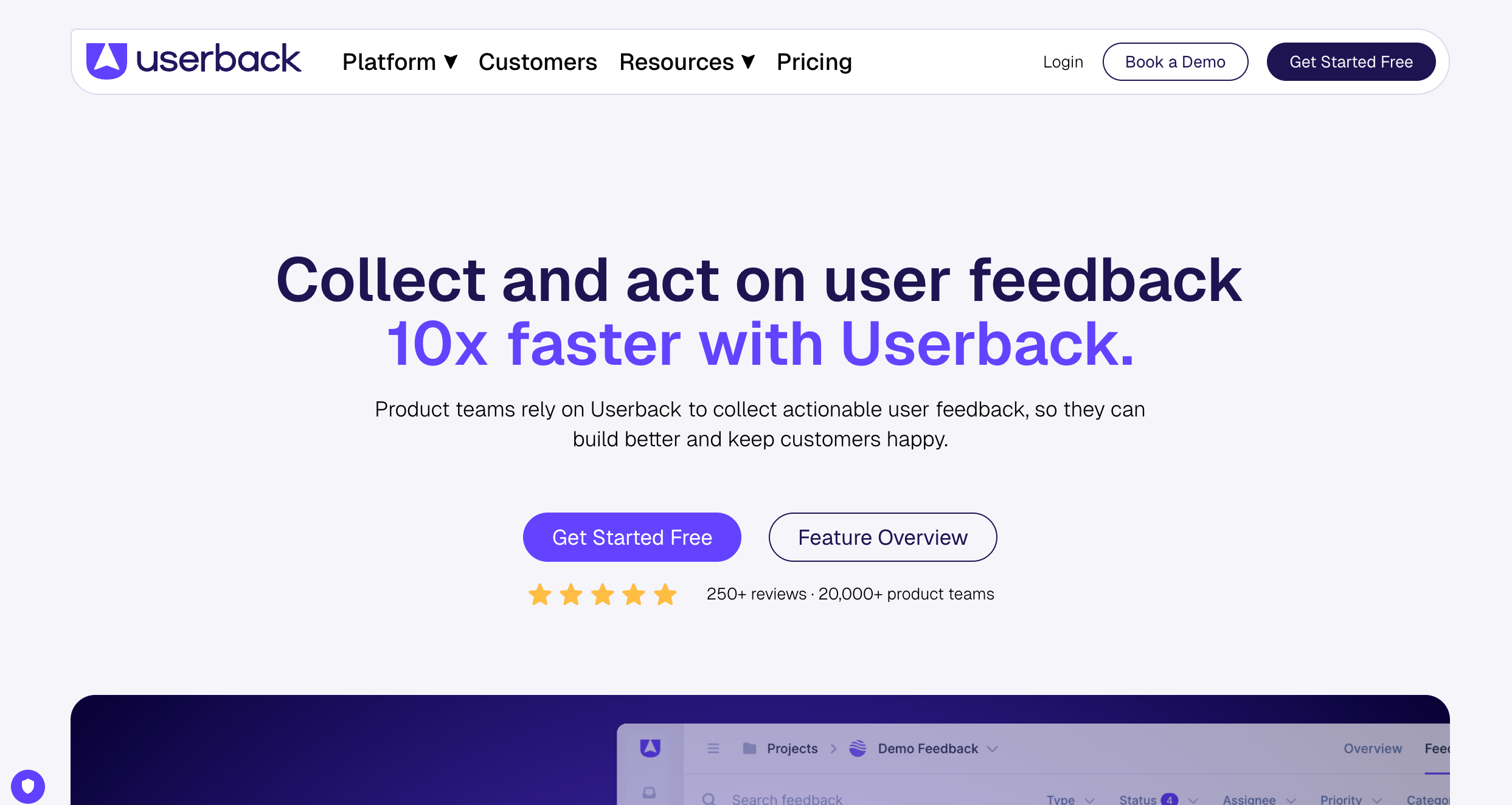
4. MarkUp.io
MarkUp.io is a visual feedback tool focused on simplifying feedback on digital content. You can upload live websites, images, PDFs, and videos, and stakeholders can leave contextual comments without needing specialized tools. It’s designed for straightforward, visual review workflows rather than deep development-level bug reporting or complex project management.
Key Features of MarkUp.io
- Supports over 30 file types (web pages, PDFs, images, videos) for review
- In-page visual comments / annotations (pins, highlights)
- Chrome extension to capture screenshots & create markups directly from browser
- Workspaces & folder organization to group markups
- No login required for reviewers
- Integration with tools (via Zapier, Slack, CMS/PM tools) for linking feedback into workflows Prioritization and basic project organization (folders, comment threads, resolution states)
Pricing
MarkUp's paid plans start with the Pro plan (around $79/month), which includes one workspace, 500 GB of storage, and access to core commenting and annotation features. For larger teams, the Enterprise plan offers unlimited workspaces, increased storage, SOC II compliance, dedicated onboarding, and priority support, with custom pricing available on request. All paid plans include unlimited collaborators, and a 30-day free trial for new users.
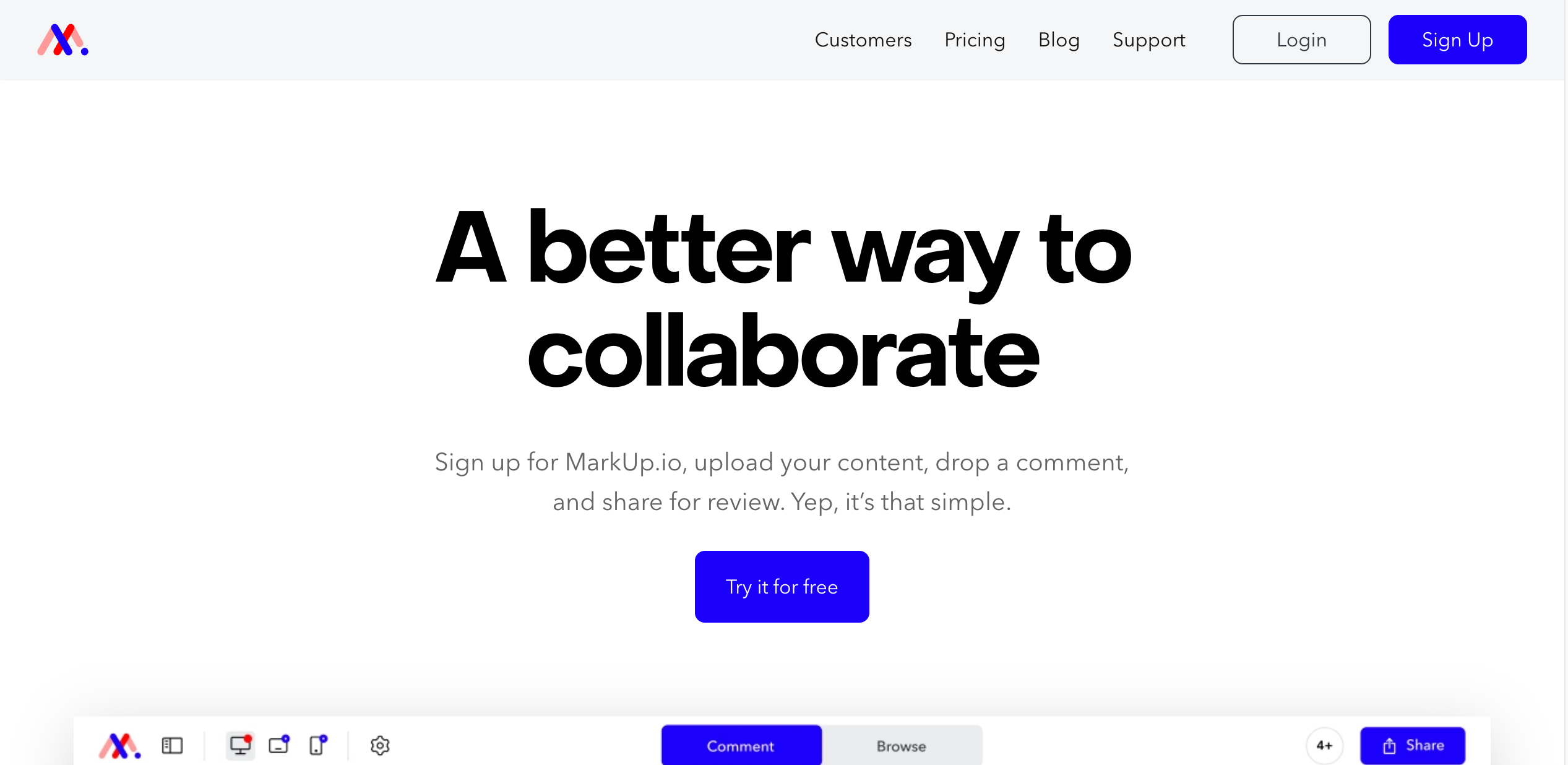
5. Usersnap
Usersnap is used by product teams, QA, agencies, and SaaS/web product developers. It enables users or clients to submit annotated screenshots, screen recordings, and microsurveys from websites or apps. Each feedback item comes with contextual metadata (browser, OS, URL, console logs) to help developers reproduce issues. It also offers workflow tools, analytics, and newer AI capabilities for summarizing and prioritizing feedback.
Key Features of Usersnap
- Visual annotation & screenshot tools (highlight, draw, comment)
- Screen recording & video feedback
- Built-in surveys / microsurveys & conditional logic forms
- Automatic metadata capture (URL, browser, device, console logs)
- Feedback management workflows
- Integrations with tools like Jira, Slack, Azure DevOps, Zendesk, webhooks, etc
- AI-assisted features: feedback summarization, urgent issue detection, smart labeling & replies
- Integrations & APIs / webhooks to sync feedback to issue trackers, team tools, custom workflows
Pricing
Usersnap offers a tiered pricing model starting with a free plan (first 20 feedback items free) and paid plans starting around $52/month for the Starter tier with limitations on number of projects and seats. Higher tiers (Growth, Professional, Premium) escalate feature access (e.g. more active projects, advanced feedback tools, custom branding, roles & permissions) up to enterprise levels with custom pricing.
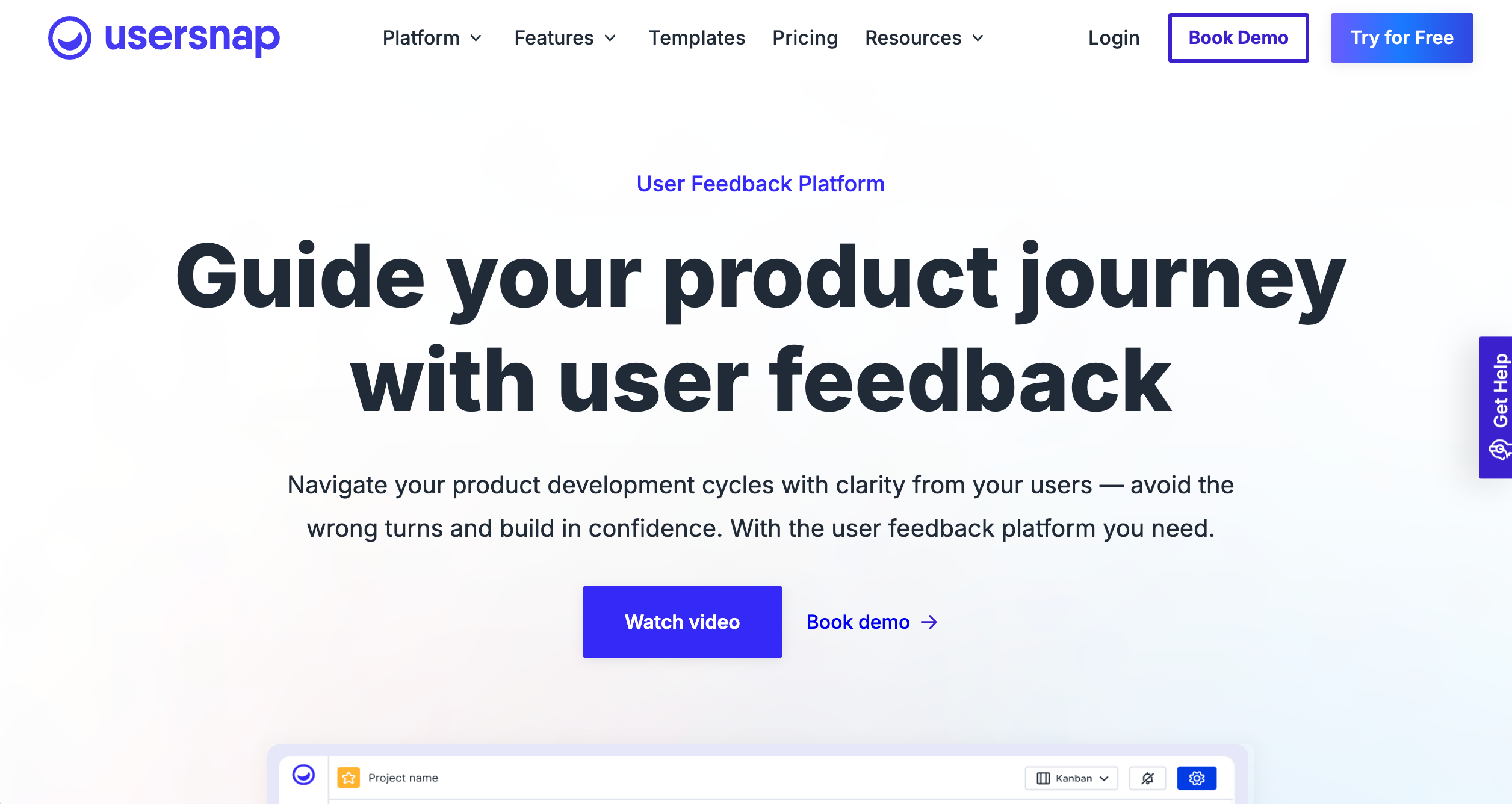
Online Survey Tools
1. Typeform
Typeform is user feedback and data collection tool which allows users to build feedback surveys, interactive forms and quizzes, and embed them as feedback widgets, pop-ups, and more.
Key Features of Typeform
- Conversational design – one question at a time for higher engagement and completion rates.
- Customizable templates – adjust colors, fonts, logos, and branding without coding.
- Conditional logic (Logic Jumps) – personalize question paths based on previous answers.
- Integrations – connect with 500+ apps (Google Sheets, HubSpot, Slack, Notion, Mailchimp, Zapier, etc.).
- Analytics & reporting – track feedback data such as completion rates, drop-offs, and time spent per question.
- Conversion tracking – integrate with Google Analytics and other marketing tools.
Pricing
Typeform offers a free plan plus three main paid tiers. The Basic plan starts at $29/month for 1 user and 100 responses. The Plus plan costs $59/month for up to 3 users and 1,000 responses, and adds branding removal and custom domains.

2. Crowdsignal
Crowdsignal (previously known as PollDaddy) is designed to collect feedback via surveys and polls.
Surveys can be embedded on your website or shared as links. Like Typeform's Logic jump feature, Crowdsignal users can use conditional branching to serve respondents questions based on their responses.
Key Features of Crowdsignal
- Surveys, polls, quizzes & ratings – create different interactive content types with 14+ question formats.
- Custom branding & design – personalize themes, colors, fonts, and even use your own CSS or domain.
- Flexible distribution – share via links, embeds, emails, and QR codes.
- Real-time analytics – track responses instantly with filtering and reporting
- Data exports & integrations – export results to Excel, CSV, PDF, or Google Sheets for easy analysis.
Pricing
Crowdsignal has a Free plan with unlimited surveys but capped at 2,500 responses, making it suitable for small projects. Paid tiers include Premium ($25/month), Business ($49/month), and the Team plan ($29/user/month) for larger teams who need collaboration features.

3. SurveySparrow
SurveySparrow enables user feedback collection from website visitors at different points in their browsing. Visitors can access SurveySparrow forms on any device. The app supports mobile devices and the survey forms have a chat-like interface by default.
Key Features of SurveySparrow
- Conversational feedback surveys – Chat-like, mobile-friendly forms that boost engagement.
- Smart logic – Conditional branching and personalization based on responses.
- Analytics dashboard – Visual reports, charts, and export options.
- Automation & tickets – Trigger alerts, assign tasks, and manage responses easily.
- Omnichannel sharing – Distribute via web, email, SMS, QR codes, WhatsApp, and more, with 1,500+ integrations.
Pricing
SurveySparrow offers a 14-day free trial and a range of paid plans to suit different needs. The Basic plan starts at $19/month for 1 user and up to 2,500 responses annually, while the Starter plan is $39/month with 15,000 responses and extra features like email embeds and survey translation.

You Might Like: How to Use Kanban for Managing Client Website Feedback
Usability and Behavioral Analysis Tools
1. Hotjar
Hotjar is an advanced analytics solution for tracking page views and user sessions. It provides form analytics and visitor logging, as well as feedback and analysis heatmaps. It's great for understanding user behavior and you can use Hotjar's analytics to track and quantify user activity, and gain detailed insights.
Hotjar provides visual depictions of customer interactions and visitors' usage patterns. You can identify your most popular website elements based on where your visitors spend the most time.
Key Features of Hotjar
- Heatmaps – visualize where users click, scroll, and move on your site.
- Session recordings – watch real visitor sessions to see how people interact with pages.
- Feedback widgets – collect in-the-moment feedback with on-site pop-ups and surveys.
- Surveys & polls – run targeted surveys to capture visitor opinions and motivations.
- User interviews (Engage) – recruit and schedule calls with users for direct insights.
- Funnels & conversion analysis – identify where users drop off in the journey.
- Integrations – connect with tools like HubSpot, Slack, Google Analytics, and more.
Pricing
Hotjar's Observe plan (heatmaps & recordings) starts free with 35 sessions/day, then scales to $39/month (Plus), $99/month (Business), and $213/month (Scale) for more sessions and advanced analytics.
Ask (surveys & feedback) is also free to start, with paid tiers at $59/month, $99/month, and $159/month, unlocking unlimited responses, advanced targeting, and AI-powered analysis. Engage (user interviews) begins free with limited interviews, with paid plans from $39/month up to $440/month, adding participant recruiting, transcription, and enterprise features.

2. CrazyEgg
CrazyEgg is one of the most well-known user insight tools for websites. Like Hotjar, CrazyEgg creates user session recordings and uses heatmaps and analytics to track user activity.
Heatmaps display the locations with the most visitor activity, revealing just what your site's visitors love. CrazyEgg's statistics are centered on user behavior and provide valuable insights into customer preferences.
Key Features of CrazyEgg
- Heatmaps & snapshots – Visualize clicks, scroll depth, and attention through heatmaps, scrollmaps, confetti, overlays, and list reports
- Session recordings – Watch user interactions and identify areas of confusion or frustration
- A/B testing & conversion tracking – Experiment with variations and measure results to optimize conversion performance
- Popup CTAs & surveys – Engage users with messages, calls-to-action overlays, and feedback collection
- Error reporting, analytics & goals – Track site errors, campaign traffic, and conversion goals for deeper analytics
Pricing
Crazy Egg offers a 30-day free trial and four annual plans. The Starter plan begins at $29/month for small sites with up to 5,000 pageviews. The Plus plan at $99/month adds more capacity, A/B testing, error monitoring, and advanced support. For larger teams, the Pro plan costs $249/month with 500,000 pageviews and 5,000 recordings.
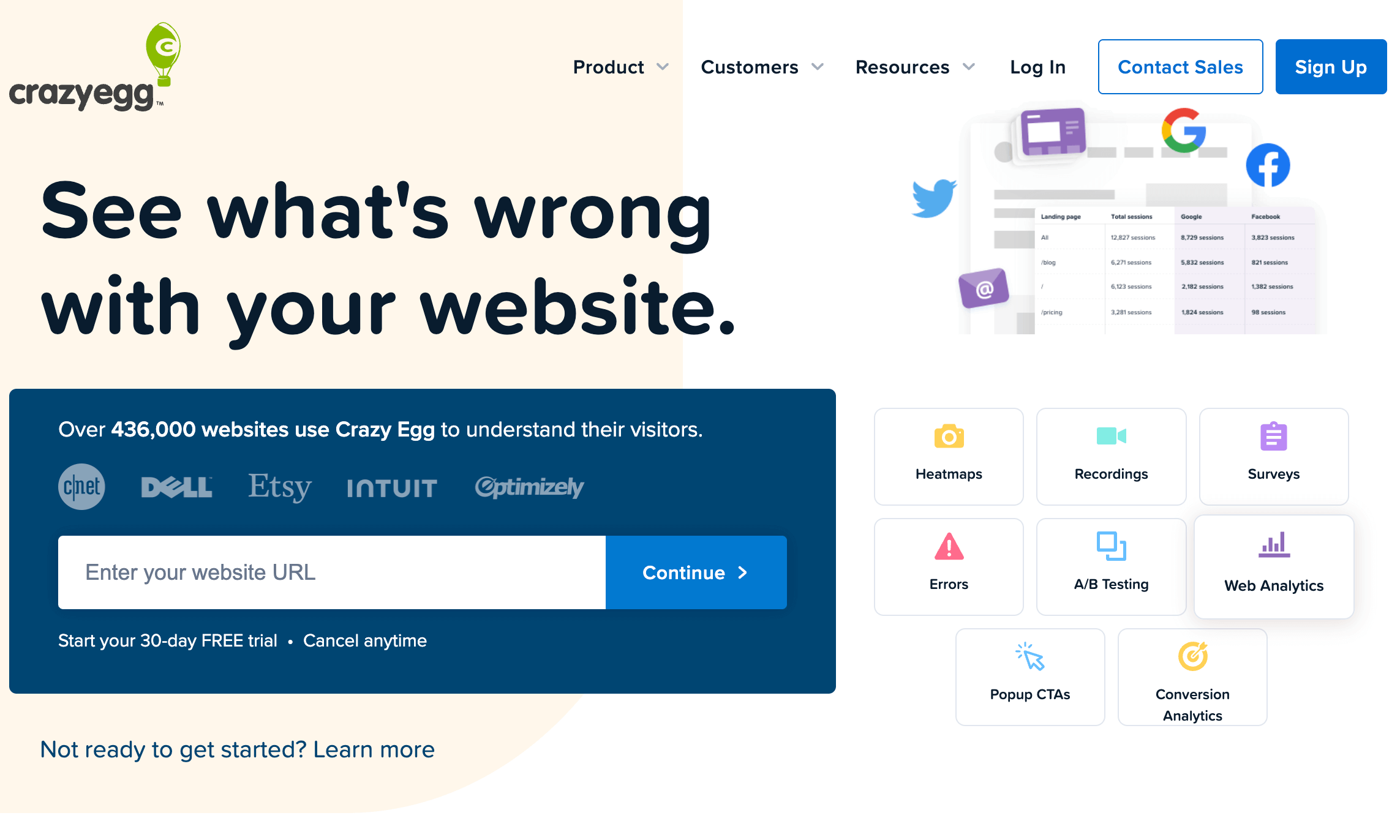
3. Mouseflow
Mouseflow is a behavior analytics software used to optimize website experiences to improve conversions.
With Mouseflow, you can gain insight into customer preferences by monitoring your website visitors' sessions and gathering heatmap data. You can also set up funnels to observe where and why visitors abandon your website.
Key Features of Mouseflow
- Session replay – Watch real users interact with your site to identify usability
- Six types of heatmaps – Analyze clicks, movements, scroll depth, attention, geo-location, and rage clicks
- Conversion funnels & journey analytics – Track user paths, detect drop-offs, and optimize flow
- Form analytics – Discover fields causing hesitation or abandonment
- Friction detection & filtering – Automatically flag sessions with frustration or errors and apply targeted filters
Pricing
Mouseflow offers a Free plan with 500 recordings per month for one website. Paid plans scale by capacity: the Starter plan at $31/month includes 5,000 recordings, while the Growth plan at $109/month allows 15,000 recordings across up to three sites. The Business plan at $219/month expands to 50,000 recordings, and the Pro plan at $399/month supports 150,000 recordings across 10 sites.

Read About: How Customer Journey Mapping Informs Better Website Builds
Voice of Customer Feedback Tools
1. Survicate
Survicate is an Net Promoter Score (NPS) customer feedback tool. Their NPS surveys and other survey templates are designed to help businesses gather customer insights during their lifecycle.
Survicate has over 125 survey templates you can use. The survey templates are fully customizable. You can set triggers to target a specific group, receive alerts when a user leaves feedback, and more. You can also edit a template's color, font, and language.
Key Features of Survicate
- Multi-channel surveys – Launch feedback customizable feedback forms across email, website pop-ups, in-app, and mobile
- Targeting & segmentation – Trigger surveys based on user behavior or CRM data, and segment feedback instantly
- AI insights – Automatically categorize feedback into themes and analyze sentiment using AI, or ask follow-up questions through an AI chatbot
- Custom dashboards – Build real-time dashboards to track NPS, CSAT, themes, and trends, all in one place
- Extensive integrations – One-click connections with tools like HubSpot, Intercom, Salesforce, FullStory, Google Analytics, Slack, and many more
Pricing
Survicate has a Free plan for basic surveys, capped at about 25 responses/month. Paid tiers start with the Starter plan at $79/month, while the Growth plan (at $49/month) adds unlimited surveys, automation, and AI analysis.

2. Qualaroo
Qualaroo is an innovative user feedback and research tool for collecting user feedback. The software uses an advanced survey program called Nudges™.
Qualaroo is excellent for targeting on and off-site visitors with targeted surveys. Businesses can gather insightful qualitative data about what their visitors want, and don't want to see on their website. The survey questions can focus on any aspect of the user experience.
Key Featurs of Qualaroo
- Smart Nudges™ & survey targeting – Trigger feedback requests based on behaviors like exit-intent, scroll depth, user identity, and custom properties.
- AI sentiment & visualization tools – Use IBM Watson to categorize emotions, visualize themes with word clouds, and auto-track metrics like NPS, CSAT, and CES.
- Branching logic & multilingual support – Personalize surveys with skip logic and reach global users with 70+ supported languages.
- Seamless integration & accessibility – Embed surveys across web, mobile, prototypes, email—and connect with tools like HubSpot, Slack, Salesforce, and Zapier.
Pricing
Qualaroo offers a Forever Free plan that includes all core features, up to 50 responses, 500 email sends, and 10,000 pageviews per month.
Beyond that, the Business plan (pricing available upon inquiry) includes everything in the Free plan, plus 24/7 support, personalized onboarding, SAML-based SSO, API access, white-labeling, and dedicated success management.
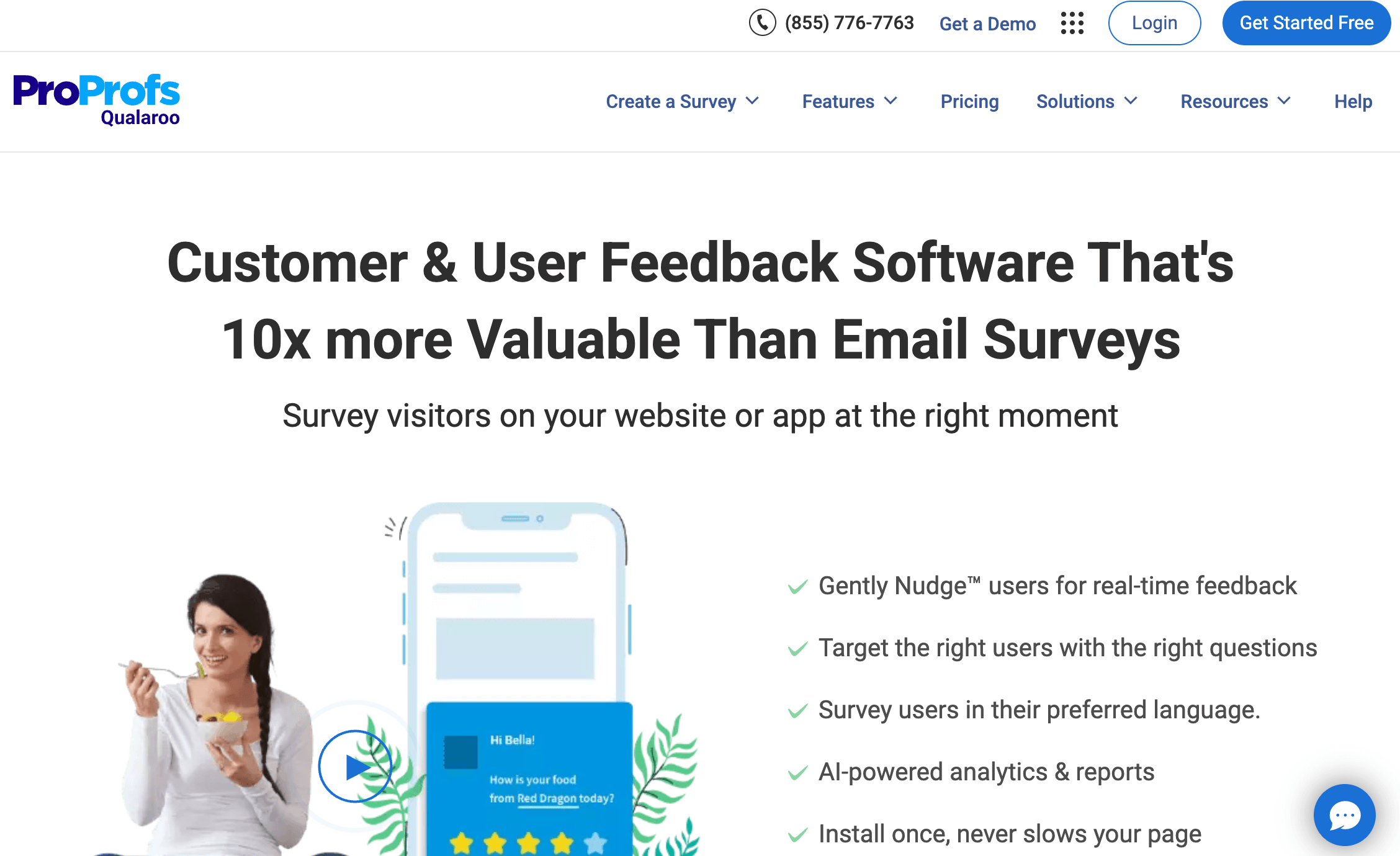
3. WebEngage
WebEngage is an omni-channel user engagement platform using automation to interact with a designated audience throughout their lifecycle.
WebEngage's capability to segment users and tailor communication is one of its best features. It offers several ways to begin a conversation, including web push, email, SMS, and push notifications. This makes it easier for the right message to reach the right person at the right time.
Key Features of WebEngage
- Unified customer data platform – Unifies customer data into a single, real-time profile for personalized outreach.
- Omnichannel campaign orchestration – Manage communications across email, SMS, push notifications, web messages, and more from one platform.
- Advanced segmentation & AI personalization – Leverage live behavioral and demographic segmentation with predictive modeling and generative AI.
- Real-time analytics & journey designer – Use visual tools to track funnels, cohorts, and campaigns, crafting automated, rule-based customer
- Seamless integrations & strong support – Integrates swiftly with third-party tools and offers onboarding and 24/7 customer success support.
Pricing
WebEngage pricing is customized based on your usage - typically starting around $199 per user per year, billed annually - and tailored according to factors like Monthly Active Users (MAU) and feature requirements. If you’re interested in trying it, you’ll need to request a demo or quote, as there's no public free tier or trial available.

Community Feedback Tools
1. UserVoice
UserVoice is an online website feedback tool that collects and organizes feedback to provide clear, actionable insight for product teams.
UserVoice bridges the divide between customer needs and functionality. It helps enterprise-level businesses collect customer feedback, manage support requests, and boost customer satisfaction.
Features of UserVoice
- Multi-channel feedback collection – Enable users to submit ideas via web portals, in-app widgets, and internal tools like the Contributor Sidebar for unified feedback
- Idea prioritization & analytics – Use voting, revenue insights, and comments to surface high-impact requests, supported by dashboards to track trending
- Team coordination & status updates – Integrate with Zendesk, Salesforce, Slack, Jira, and more to sync feedback into workflows; automatically notify users when ideas move
- Roadmapping & segmentation – Organize feedback by user/account data, merge duplicates, and filter ideas to build transparent, prioritized product plans.
Pricing
UserVoice pricing is structured into three tiered plans: Growth, Team, and Strategic Pricing starts at $899/month for the Growth plan (up to 1,000 users), increases to $1,199/month for the Team plan (up to 3,000 users), and reaches $1,349/month for the Strategic plan (up to 5,000 users).

2. Helprace
Helprace is a cloud-based customer service and helpdesk software application with a ticketing system.
Helprace is designed for collecting feedback and building an internal knowledge base. It incorporates multiple tools in a single platform so that businesses can provide superior customer service.
Key Features of Helprace
- Integrated ticketing system – Manage support via email, phone, and internal workflows with automation, saved replies, SLAs, and reports
- Knowledge base & self-service portal – Set up public or internal documentation with smart search, article usefulness ratings, and crowdsourced FAQ contributions
- Community feedback & idea management – Facilitate discussions, collect suggestions, enable voting, moderate topics, and display the best replies
- Customization & control – Use domain mapping, SSL, custom fields, user groups, and regional data hosting to tailor your support experience
- Scalable modules – Choose standalone components like Tickets, Community, or Docs—or go for the Complete package for full functionality
Pricing
Helprace offers a 30-day free trial, then transitions to modular pricing depending on selected features:
- Tickets, Community, Docs modules each cost $18/agent/month when billed annually ($20 monthly)
- Self‑Service or Helpdesk packages are $27/agent/month annually ($30 monthly)
The comprehensive Complete plan is $36/agent/month when billed annually ($40 monthly)

3. UserEcho
UserEcho is a user feedback tool that helps you provide robust customer support via helpdesk, knowledge base, and live chat.
Your customers can participate in ongoing forum discussions or use educational posts to evaluate your products and services. Customers can also click on a feedback button to initiate a live chat session with your customer service team.
Key Features of UserEcho
- Community forums with voting – Let users discuss ideas and vote, enabling crowdsourced insights
- Helpdesk ticketing system – Capture and manage customer queries via email, chat, or support portal
- Knowledge base with smart search – Users find answers faster using auto-suggest and Fcategorized articles
- Live chat – Offer real-time assistance directly from your support portal
- Analytics & feedback tools – Track engagement, forum usage, and agent performance with built-in reports
Pricing
UserEcho offers a Free trial, with full functionality for one support agent at around $19/month. Optional upgrades include white-labeling (approx. +$100/month), additional subdomains (+$15/month each), and branding customization (starting from $500).

Conclusion
With the right tools, gathering website user feedback can be an insightful and productive process. The right tools are also necessary for gathering mobile app feedback as the objective is the same - understanding user experience, fixing bugs quickly, and completing development projects efficiently so that your clients have the best experience.
“Implementing effective customer feedback methods can provide invaluable insights that drive product development, enhance customer satisfaction, and foster loyalty." - Business Marketing World
The website feedback tools outlined here can help you to not only manage the feedback loop effectively, but also uncover customer preferences, and exceed their expectations. Many of the tools, including BugHerd, offer a free trial you can use to achieve your immediate goal before committing. Start a free trial of BugHerd here
Read Next: 17 Time Saving Tools and Templates for eLearning Designers

Frequently Asked Questions
How do website feedback tools install?
Website feedback tools are usually installed via a lightweight JavaScript snippet on your site or a browser extension. BugHerd offers both, so agencies can deploy in minutes without touching core code.
Which website feedback tools are better for agencies?
Website feedback tools built for non-technical clients that include in-built task tracking are the best for agencies. BugHerd is popular with agencies because clients can point-and-click right on the issue where it occurs. Every comment automatically comes with a screenshot along with user technical details, and then becomes a trackable task on a built-in Kanban board; making it easy for web teams to manage and action.
Will a feedback widget slow down my website?
Done right, no - modern widgets load asynchronously and add a negligible footprint. BugHerd loads async and won’t block rendering.
How do these tools affect performance and Core Web Vitals?
Website feedback tools have a minimal impact on core web vitals (CWS) when scripts are async/deferred. With BugHerd, keep it on staging (and post-launch only where needed) to protect CWV on critical pages.
Can clients leave feedback without logging into a website feedback tool?
Yes with the right tool. BugHerd lets clients leave feedback via share links - no login needed - so getting started is easy.
What security and privacy standards should a website feedback tool meet?
Look for encryption in transit/at rest, SSO/SCIM options, access controls, audit trails, and GDPR compliance. BugHerd follows industry-standard security practices and offers role-based access. More on BugHerd's privacy and security policy.
How do I capture automatic technical context with each report (URL, browser, OS, screen size, console logs)?
Choose a tool that attaches context automatically. BugHerd auto-captures URL, browser, OS, screen size, and a screenshot; console/network details can be added via your workflow or integrations.
When should I use video feedback vs annotated screenshots during website reviews?
Use video for flows, animations, or intermittent bugs; use screenshots for static UI tweaks. BugHerd supports both, so users pick what conveys the issue fastest.
Do website feedback tools support feedback on PDFs, images and design files, as well as live websites?
Some do. With BugHerd users can easily leave feedback on websites plus PDFs, images and Figma files for design/content approvals.
What’s the difference between visual pin-and-comment tools and session replay?
Pins = explicit feedback (“change this”). Replay = implicit behavior (what users did). Many teams use both. BugHerd covers the pin-and-comment layer and connects with replay tools if you want deeper context.
How do I integrate feedback with my project management tools (eg. Jira, ClickUp, Trello, Asana, GitHub, Slack, etc)?
Some website feedback tools have native integrations into some project management tools; while others use connectors like Zapier, Make or Integrately. BugHerd has two-way integrations with project management tools such as Jira, Trello, Asana, GitHub and more, and also integrates with Slack, Teams, WordPress, Productive, Harvest, etc.
Can I brand the widget and emails to match my agency (white-labeling and custom domains)?
Yes - look for branding controls. BugHerd offers customizable branding so the experience feels like your process.
Are there best practices for organizing boards (labels, priorities, duplicates) to prevent scope creep?
With a in-built Kanban board, prioritzation and simple labelling, BugHerd’s task board makes it easy to triage the feedback from your clients and team. Remove duplicate tasks, assign them to your team for completion, and set severities.
How do I keep clients updated on progress without long email threads (notifications, reports, shareable views)?
Give them a live view of a task board and automated notifications. BugHerd's in-built Kanban board shows status at a glance and can notify clients only when items are “Ready for Review.”

















But don't just take our word for it.
BugHerd is loved by 10,000+ companies,
350,000+ users across 172 countries.
4.8/5
4.7/5
4.5/5
5/5
8.7/10
Sam Duncan 📱📏 🌱
@SamWPaquet
"@bugherd where have you been all my life??
We just migrated our bug tracking over from Asana and have at least halved our software testing time🪳👏📈. "
Ashley Groenveld
Project Manager
“I use BugHerd all day every day. It has sped up our implementation tenfold.”
Sasha Shevelev
Webcoda Co-founder
"Before Bugherd, clients would try to send screenshots with scribbles we couldn't decipher or dozens of emails with issues we were often unable to recreate."
Mark B
Developer
“A no-brainer purchase for any agency or development team.”
Kate L
Director of Operations
"Vital tool for our digital marketing agency.”
Paul Tegall
Delivery Manager
"Loving BugHerd! It's making collecting feedback from non-tech users so much easier."
Daniel Billingham
Senior Product Designer
“The ideal feedback and collaboration tool that supports the needs of clients, designers, project managers, and developers.”
Chris S
CEO & Creative Director
“Our clients LOVE it”
Emily VonSydow
Web Development Director
“BugHerd probably saves us
at least 3-4hrs per week.”